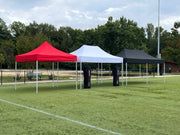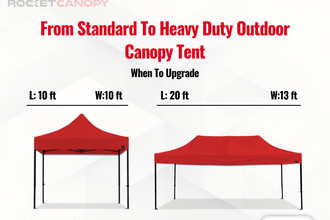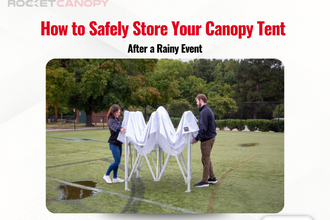
Canopy Tent Size Guide: Find the Perfect Tent for Any Occasion
Choosing the right canopy tent size is about more than just square footage. The right tent delivers comfort, coverage, and a professional look—while the wrong one can create layout issues, crowding, or wasted space.
This guide breaks down how to choose the best canopy tent size based on your setup, guest count, surface type, and event goals.
Table of Contents
How Are Canopy Tent Dimensions Measured?
Before diving into different tent sizes, it helps to understand how those dimensions are calculated and what they mean in practical terms.
Tent sizes are listed by footprint (length × width), such as 10×10 ft. Always factor in usable space versus total footprint—thicker frames and sidewalls can slightly reduce interior room.
Height matters too. The Rocket Canopy frame adjusts from 72.8 to 87.4 inches of head clearance, with a peak height of 140 inches for visibility and airflow. That flexibility makes it ideal for everything from tall signage to stage setups.
Key Factors That Affect Tent Size Needs
Several practical considerations go into choosing the right canopy tent size. Think through these areas before making a decision.
Guest Count & Seating Style
Guest count and seating style affect how big of a canopy you need. Here are some seating arrangements to consider:
- Standing reception: allows tighter spacing
- Banquet tables: require more space per guest
- Theater-style rows: more efficient for audience setups
Equipment & Furnishings
Tents need to accommodate everything from tables and chairs to registration desks, DJ booths, or product displays. The more gear you add, the more room you’ll need.
Surface Type
While surface type doesn’t always impact the size of the tent directly, it does influence how you secure it. Make sure you're prepared with the right anchoring method based on the ground you're working with:
- Grass: Use heavy-duty stakes
- Pavement/Asphalt: Go with stackable weight plates (22lb, 33lb, or 44lb)
- Decking: Water weight bags offer secure anchoring
Event Duration & Weather
Longer events benefit from extra space for shade, storage, or weather protection. Add sidewalls or covered entryways as needed.
Learn more about how long you can leave pop-up canopies outdoors.
Transport & Storage
Larger tents take up more room in your vehicle and storage area. Make sure your setup team and transportation can handle it.
Standard Canopy Tent Sizes & What They Fit
Here’s a quick breakdown of the most common canopy tent sizes and how they’re typically used.
10x10ft (100 square feet)

- Fits 1–2 tables or 6–10 standing guests
- Ideal for small vendor booths, farmers markets, or personal tailgating setups
10x15ft (150 square feet)

- Fits 2–3 tables or 10–15 standing guests
- Great for larger vendor spaces, catering setups, or mobile vehicle services
10x20ft (200 square feet)

- Fits 3–4 tables or 15–20 standing guests
- Suited for mid-size event booths, small parties, or promotional events
What are the Ideal Tent Sizes for Different Occasions?
Certain tent sizes consistently work better for specific event types. Here’s a quick reference guide to help you match size to occasion.
| Event Type | Recommended Tent Size |
|---|---|
| Markets, Expos, Small Vendor Booths | 10×10 ft |
| Tailgates | 10×10 ft or 10×15 ft |
| Receptions, Craft Fairs, Networking Events | 10×15 ft |
| Large Family Events, Outdoor Weddings, Conferences, Vehicle Detailing Services | 10×20 ft |
One Big Tent or Multiple Smaller Ones?
If you need to cover a larger area, you’ll need to decide between one large tent or several smaller ones. Each approach has its benefits depending on your event layout.
Single Large Tent
- Creates a seamless, professional space
- Ideal for expos, weddings, or festivals
- Easier to anchor and manage
- May lack layout flexibility
- Typically more budget friendly than purchasing multiple.
Multiple Small Tents
- Allows modular setups for food, seating, and displays
- Easier to transport and set up
- Better for changing layouts or shifting weather
- Requires more time to anchor and connect properly
First-Time Buyer Tips

Buying a tent for the first time? These tips can help you make the most informed decision based on your current and future needs.
-
When in doubt, size up.
It’s better to have room to grow than run out of space. -
Think multi-purpose.
A 10×15 tent works for both business events and backyard parties. -
Plan for gear.
Don’t forget to factor in tables, signage, and foot traffic. -
Check your vehicle.
Larger tents need more cargo space and setup manpower. -
Understand regulations.
Some venues limit tent sizes or require permits. -
Allow for branding.
Larger tents mean more space for logos, banners, and displays.
Make the Smart Choice
Choosing the right tent size sets the tone for a smooth setup, comfortable guests, and a more polished presentation. With a little planning, you can find a tent that meets your current needs and adapts to future ones.
Looking for a tent that’s the right fit? Browse Pro Series canopy tents or shop Sport Series canopy tents.
Frequently Asked Questions about Choosing a Tent Size
Start with guest count, layout style, and equipment needs. Always allow space for walkways and stations.
A 20×20 ft tent works well for seated events without a dance floor. This can be arranged with 2 10x20 canopies.
A 10x10 ft canopy is perfect for small booths, personal gatherings, or tailgating, fitting about 6–10 standing guests.
10×10 and 10×15 tents fit in most SUVs. 10×20 tents may require a truck or van.





